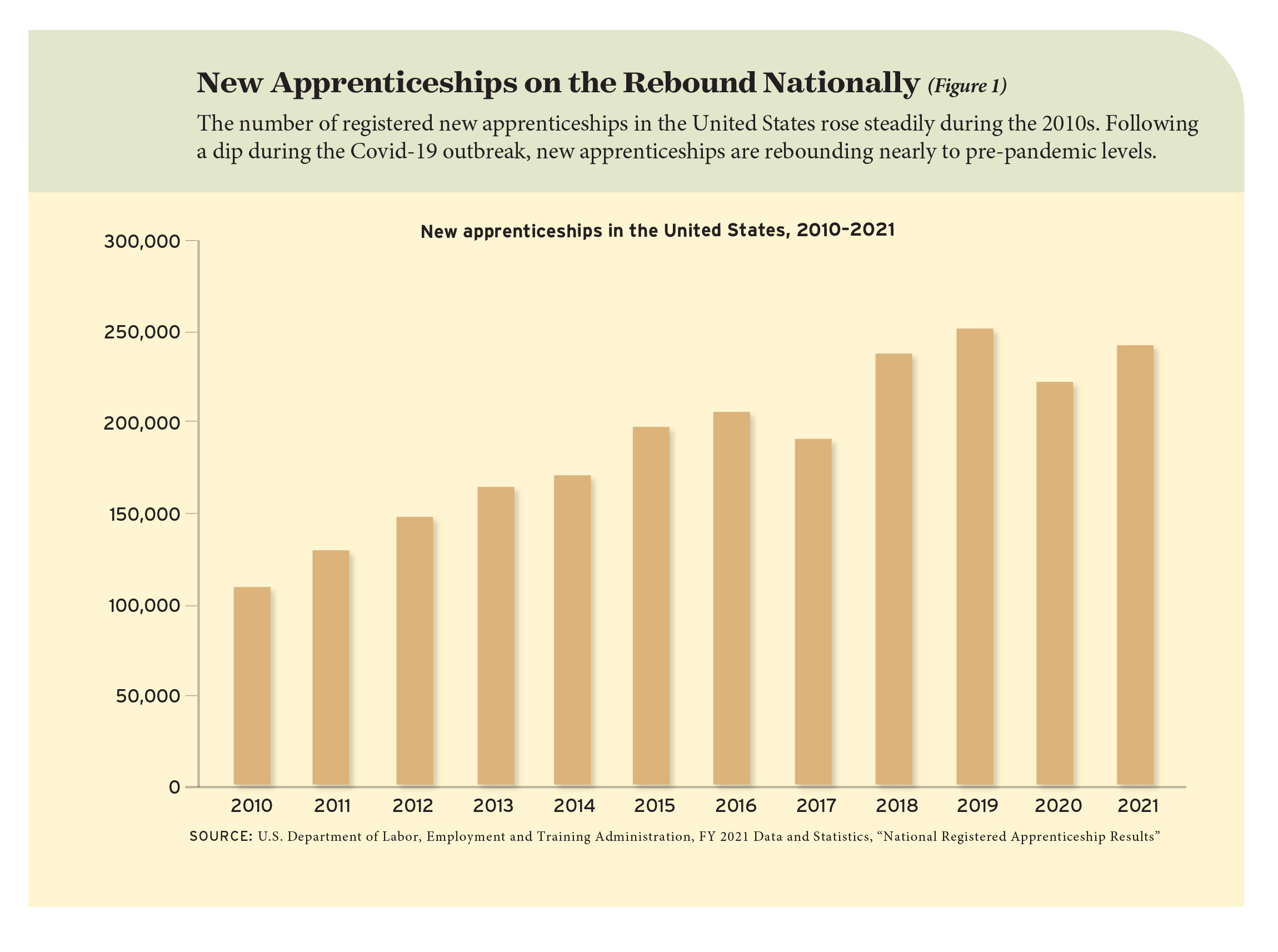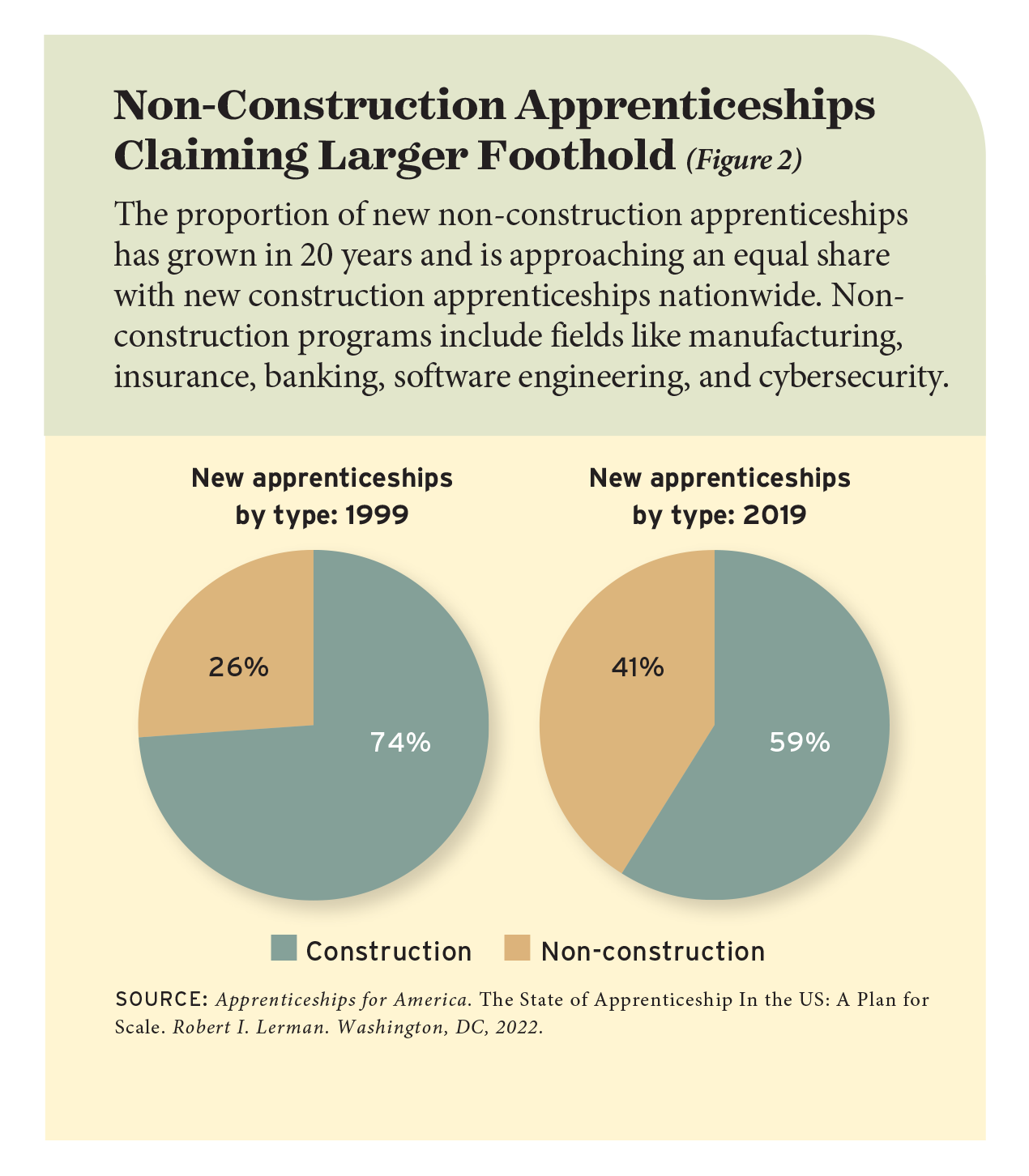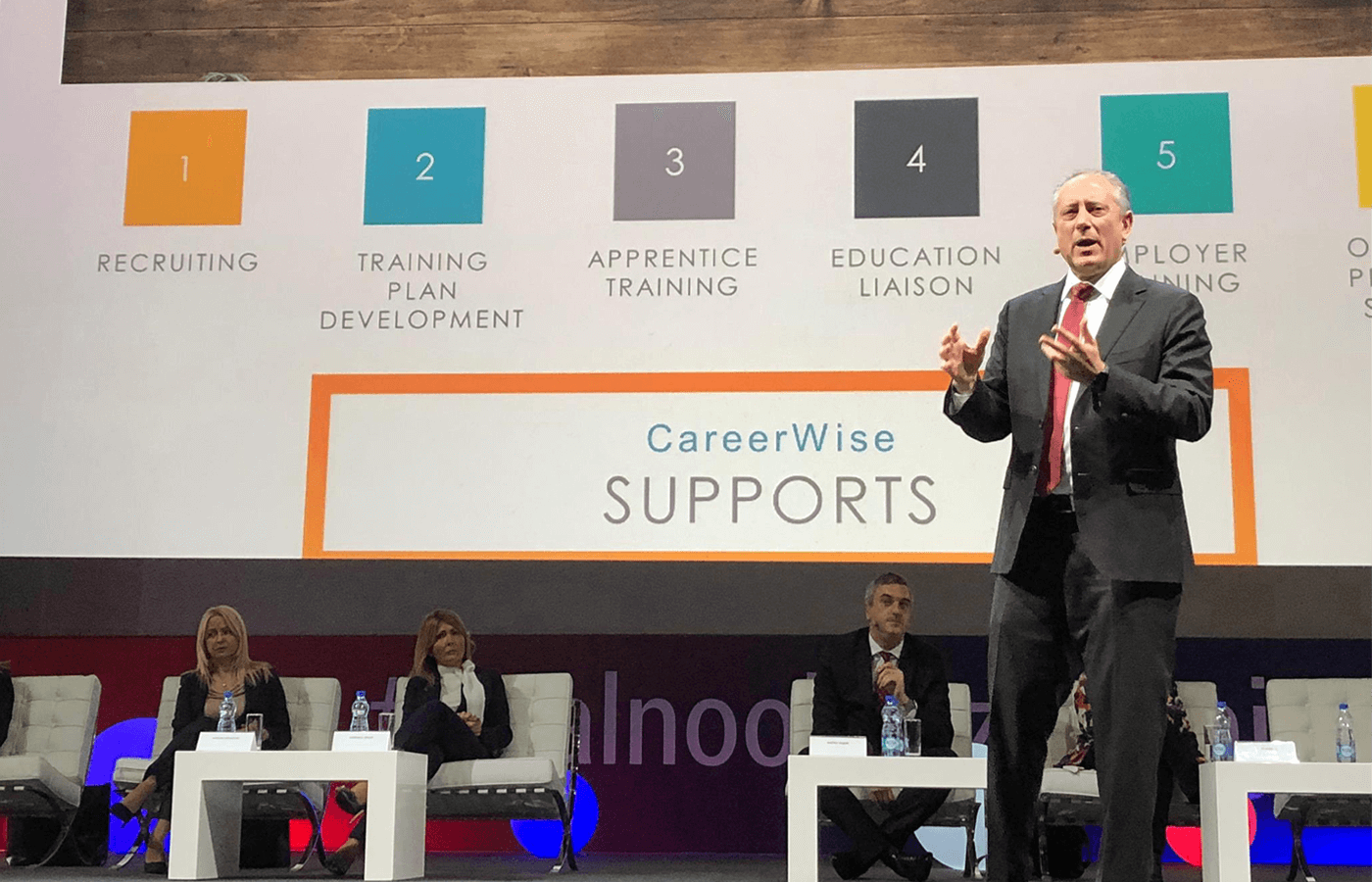
Lakshmi Balasubramaniam had tried to launch her career by the traditional route. It just wasn’t working the way she wanted.
Balasubramaniam, 25, went to college just like you’re supposed to and earned a degree in industrial management from the University of Cincinnati in 2019. But she spun her wheels for two years in retail and call-center jobs with low pay and little opportunity for advancement.
Then a family friend told her of an emerging path for moving ahead—a reimagined and condensed form of apprenticeship that would let her pursue her interest in technology, train for a job, and get paid while doing so.
Early in 2022, she started a cybersecurity apprenticeship that gave her three months of training and then placed her in an information technology job with added support for a year. She hopes her training and that year of experience will prepare her to land a full-time job at that company.
The appeal of the apprenticeship was that it offered both pre-service and on-the-job training. “It really sparked my interest,” Balasubramaniam said, “because it would give me what I needed to be successful. Then I will be able to go on and do what I love.”
Apprenticeships that enable young people to learn job skills while working and drawing a salary are nothing new in Europe, where they are a respected and common path to careers in many fields. There, they sometimes take the place of college in preparing students for well-paying jobs, or they may serve as a steppingstone to advanced university training. They can even launch workers on a path to running large companies.
In the United States, though, apprenticeships have traditionally centered on construction trades such as carpentry and plumbing, and they are run through unions rather than by companies, as in Europe. They are viewed as paths to blue-collar jobs, and students who are looking to build a white-collar and well-paying career often choose college instead.
But that’s changing. With college-loan debt making many rethink the country’s college-for-all mindset, apprenticeships are becoming more attractive. Apprentices can earn a paycheck while they train, sometimes even acquiring an associate degree on company time and on the company’s dime. And apprentices can earn middle-class wages without incurring the loan debt that hobbles the finances of many college goers through their 20s and even 30s.
Before the pandemic, the number of people starting apprenticeships had more than doubled over the previous 10 years. That progress stalled during Covid’s height, but data for 2021, the most recent available, show that apprenticeship starts had rebounded to near the 2019 peak (see Figure 1).

Even more important, apprenticeship programs have sprouted across the country in fields such as manufacturing, insurance, and banking as well as in technical fields such as cybersecurity, software engineering, and digital marketing. Before the pandemic, new apprenticeships in non-construction fields had risen to 41 percent of all apprenticeship starts in 2019, from 26 percent in 1999 (see Figure 2), as reported through the Registered Apprenticeship Partners Information Database System. (These percentages capture about two-thirds of all apprenticeship starts in the country, since most but not all states use this system to manage information on their respective apprenticeship programs.)

The style and length of apprenticeships is also changing. Some of these new apprenticeships are adapting traditional European models, in which companies hire and train their apprentices, who also attend school part time.
But some are using variations of a new approach, cast as “hire-train-deploy” by one key player, in which third-party intermediaries make apprentices their “product.” These intermediary companies, both for-profit and nonprofit, have sprouted up in recent years to recruit, train, and match employees such as Balasubramaniam with other firms for a commission, functioning somewhat like a temp agency.

It’s a lighter, shallower, faster approach than those taken by typical European apprenticeships that last three years or more, or the traditional apprenticeships in the United States that span about four years. They also differ sharply from European apprenticeships by having the intermediary—not the end company—hire the apprentice at the start.
“Hire-train-deploy is the apotheosis of apprenticeship,” said Ryan Craig, who coined the term and founded Achieve Partners, a New York investment firm that has become a major player in the field. It’s a model that allows clients to “try before they buy,” he said. “That matters a great deal to skittish companies.”
The rise in apprenticeships and the variety of fields and approaches is encouraging to Robert Lerman, a researcher for the Urban Institute and co-founder, with Craig, of Apprenticeships for America, a national organization that promotes this form of training while working.
Lerman’s goal: develop standards for learning and a way to make apprenticeships affordable for companies. Training and paying recruits at the same time is expensive, he and other advocates note. And financial aid for work-based learning in the United States doesn’t come close to what is available for college study.
That could change in the next few years, as advocates have already started proposing ways to use more federal tax dollars to support training and apprenticeships, either through new taxes or by changing rules for existing funds. But while there is agreement on both sides of the Congressional aisle that apprenticeships should expand, there’s no consensus on exactly how to make that happen.
Apprentices need to earn valuable skills, but they don’t want to get locked into one company for life. At the same time, employers need assurances that investing in an apprentice will pay off and that they won’t simply be training employees for their competitors. And there’s debate over how much control the government should have over apprenticeship programs and how much should be left to individuals and industry.
If the right balance can be found, Lerman thinks apprenticeships could be a good fit for 25 percent to 30 percent of young people in the United States. That would be a dramatic increase over the 1 percent of youth and young adults estimated in 2018 to be embarking on apprenticeships after high school. It would also put the United States in the same ballpark as worldwide leaders such as Germany and Austria, where an estimated 33 percent of young people participate in apprenticeships.
“I strongly believe that the United States could bring apprenticeship to scale,” Lerman said.

Apprenticeships in Flux
The rise of third-party intermediaries and the new hire-train-deploy form of apprenticeship constitute perhaps the most striking developments in a field that is working through several major transitions at once. As the world emerges from the Covid-19 pandemic, a significant reshaping of the job and training market is taking place. And interest in non-college (read: no-debt) career training is surging as loan burdens overwhelm not only many recent graduates but especially young people who start college, take on debt, and don’t finish a degree.
Though most research still indicates that, in general, a bachelor’s degree leads to better outcomes than technical training over the long term, other researchers such as those at Georgetown University’s Center on Education and the Workforce have shown that many “good jobs” don’t need a four-year degree. In some new apprentice programs, participants earn an associate degree from a community college. Anthony Carnevale, the center’s director, is among those who support making such degrees part of free public education.
In this context, European-style apprentice programs are growing across the United States, while youth apprenticeships—those that start during the high school years—are gaining attention and expanding.
The post-secondary apprentice program that the German American Chamber of Commerce of the Midwest started in five Illinois companies in 2015 now operates in nine states: Georgia, Illinois, Indiana, Minnesota, Missouri, Nebraska, Ohio, Texas, and Wisconsin. It also has a sister program in Michigan.
This model focusing on advanced manufacturing has apprentices splitting time between the company and the local community college, with the company paying tuition and apprentices ideally earning an associate degree along with industry credentials.
As of summer 2022, the program had more than 190 active apprentices, the chamber reports.
Swiss-inspired CareerWise, which started in Colorado in 2017, has about 400 high school juniors each year starting three-year apprenticeships in four states plus Washington, D.C. This past fall, it launched in Buffalo, New York, and announced major growth plans in New York City with support from the CEOs of JP Morgan Chase and Accenture.
The German American Chamber of Commerce and CreerWise are leading pioneers in the move to make apprenticeships in the United States a cost-effective talent pipeline and not just a community relations strategy for companies. Both organizations say they bring a real return on investment to companies, even without the federal aid some are clamoring for.
Mario Kratsch, vice president of the German American Chamber of Commerce’s Midwest branch, said apprentices may cost a company money at first, but firms in his network say they start seeing some returns in year two and large ones in year three. Kratsch also reminds companies that they already incur costs when they recruit workers or lose production time because of employee vacations or staffing problems.
“Usually it’s eye-opening to see how much money they currently spend just to keep up with the status quo,” he said. “You’re throwing money out the window. If you add a little bit, a little tiny portion of that . . . in starting an apprenticeship program, then this will help you reduce that amount that you spend to keep up.”
Noel Ginsburg, who founded CareerWise and also serves on the U.S. Department of Labor’s Advisory Committee on Appren-ticeships, said those costs amount to a “built-in tax that’s invisible to business” but that should be weighed as the country debates how to invest in the workforce going forward.
“That tax,” he said, “is caused by employees coming in without the skills they need to be productive” and yet swelling the payroll. He said this hidden “tax” far exceeds any actual training tax that might be considered, “but we’re just used to it. So if you’re actually going to compete globally, you’ve got to fix that problem.”
Some companies express concern that they could invest in training a worker for three years only to see them take those credentials to a competitor. Kratsch counters that companies should instead think about what happens if they don’t train employees and these ill-prepared workers stick around.
And he said companies gain an advantage by recruiting talented people while they’re young and building a company and culture that make employees want to stay.
The poaching problem is less of a worry in Europe than here, Kratsch and others say, because so many European companies train apprentices that there is a greater talent pool to hire from. But the German adaptation here calls for people to commit to staying two years after they complete their apprenticeships—much the way the U.S. military academies do—so that employers have time to see the benefits of their investment.
A New Model Emerges
A new and growing 15-month model has its roots in Britain. Apprenticeships there have increased 500 percent since the 1990s, largely by having third-party intermediaries do the training, which is funded by tax revenue. This growth has come mostly in the fields of business, health care, and commerce, not the traditional skilled trades. Technology apprenticeships have also increased lately.
In the traditional European model, a government body or other legally designated organization serves as the bridge between schools and employers to align teaching with industry needs and help ensure that skills fit the common requirements of a sector.
In Germany, for example, the chamber of commerce fills that role, even creating and administering exams for career credentials. In the Netherlands, a collaborative organization for vocational education known as SBB has legal power to drive cooperation between business and schools.
In England, third-party trainers and organizing companies grew dramatically as funding shifted in the 1990s, letting many and often specialized options sprout from the ground up without the centralized and top-down structure seen on the continent. This new model is starting to take hold in the United States, particularly for tech credentials.
Apprenti, a Seattle-based nonprofit intermediary, is one of the leaders in the short-term tech apprenticeship arena. It started in 2015 as part of the Washington Technology Industry Association, a group with board members from Amazon, Microsoft, and Salesforce, as a way to train people for technology jobs. Apprenti now reports taking on apprentices in 27 states.
Lakshmi Balasubramaniam in Ohio is one of these apprentices. Her apprenticeship, which typifies the emerging model, began in January 2022 with a 13-week coding boot camp funded by Apprenti. The organization paid her $15 an hour as a full-time employee. She then started working in cybersecurity and quality assurance at $24 an hour for Great American Insurance Group in Cincinnati, still as an Apprenti employee; Great American pays Apprenti a higher rate for her service.
Balasubramaniam hopes Great American will keep her on when she finishes.
“I definitely want to continue on after I finish,” she said. “They have mentioned really liking the work that I’m doing, so I am very hopeful for that.”
In recent years, other companies have started seeking to make profits as intermediaries. Multiverse, a British company founded in 2016 by Euan Blair (son of former Prime Minister Tony Blair) expanded into the United States in 2020. The company says it is now running apprenticeships in technology and business skills for more than 40 U.S. companies and 500 firms worldwide, with Google, American Express, and Verizon among those publicly advertising these opportunities.
Blair said that colleges are not properly preparing people for jobs, and companies don’t typically have the ability to train new employees. That’s where apprenticeships come in.
“We really suffer if we decide that academic credentials are the pinnacle, without any good evidence to support them being at all useful or correlative to anything in the labor market,” Blair said.
In New York, Achieve Partners has been buying up training companies across the country to add to its portfolio and promote career training that bypasses college.

Achieve Partners’s Ryan Craig, author of two books about the limits of college in job preparation and an upcoming one, Apprentice Nation, said many young people are looking for training that doesn’t demand the investment of time and money that college does. Craig, like Blair, said that companies have a real need for employees who can do the job now, not a year or more down the line, and they don’t have the staff or facilities to offer serious training. Companies like those in his portfolio can fill that need.
“The lesson we’ve learned from looking internationally as well as in the U.S. is that every economy and every sector where apprenticeships proliferate, it’s because there are high-intervention intermediaries who do most or all of the heavy lifting for employers,” Craig said. “We don’t have that here, outside the construction trades.”
In some cases, the intermediary can be a chamber of commerce or local sector partnership. In Cleveland, Ohio, manufacturing organizations banded together to organize a small apprentice program that is still sorting out the cost and length that will be attractive to employers. On a parallel track, the chamber of commerce there, the Greater Cleveland Partnership, has worked with its local information-technology sector partnership to start an apprentice program in that field.
Even then, the chamber linked with Apprenti and with another company, Interapt, to connect apprentices with private trainers and navigate federal and state registration and laws.
It’s not an easy task, said Kratsch. German companies with Illinois factories approached the chamber for help in navigating labor law, meeting standards for German credentials for apprentices, and setting up partnerships with community colleges to provide the technical training in advanced manufacturing the companies needed. The chamber even runs “train the trainer” sessions so company staff know how to teach apprentices.
Challenges and Costs of Lite Apprenticeships
Jennifer Carlson, co-founder and executive director of Apprenti, said she tried to follow the lead of Germany and Finland in developing Apprenti’s plan but had to make concessions to employers who balked at spending money on three, four, or five years of training.
“The U.S. system was just simply not in place to think through a four- or a five-year apprenticeship model when it came to technology roles,” Carlson said. “I do think that it will get there down the road, but near-term, the companies that we were working with wanted it bigger, better, faster. And so we accelerated the training and compressed the front end, and then they get people on the job.”
That has a drawback, she said. Apprenti’s staff have observed that, with short-term apprenticeships, workers end up needing to level up their skills before long. They need “pieces that probably would have been incorporated if we had gotten a company to agree to a three- or a four-year apprenticeship where there had been additional training,” Carlson said. “We kind of had to take a big step backwards to even get any kind of adoption in the U.S.”
Kratsch said the impatience of employers is more of a challenge here than it is in Germany.
“It’s really hard to have a company committing to a mid- to long-term strategy and following that strategy in the United States,” he said. “The cycles are pretty much very short. In Germany those companies have a strategy we’re looking at, like, ‘How many people do we need in the next 10 to 15 years in which position?’ and that’s when they start right now preparing those people to fill those positions.”
The limits of the quicker apprenticeships have drawn concerns from experts looking at England, too, suggesting that the model needs work. An assessment of apprenticeships there by the Organisation for Economic Cooperation and Development in 2018 praised the growth of training but highlighted worries.
“There is still a long way to go to establish an apprenticeship system in England to match those of the strongest countries,” the report states. “A large proportion of apprenticeships in England still involve low-level skills, acquired in a period of little more than a year, with a limited component of general education, and with most of the training taking place off the job. Work-based learning is under-developed.”
But even the shorter apprenticeships take a substantial investment. Companies pay apprentices as full-time employees for the hours they work and often while they are attending school, too. Any needed additional training—termed “related technical instruction”—adds significant costs, whether done by the company itself, yet another training company, or a community college.
In Europe, publicly funded schools work with industry to do that training as a public service, letting companies there avoid costs U.S. companies would have to pay themselves.

Public Funding Options
Free community college, in line with Carnevale’s call to better prepare students for work by offering 14 publicly funded years of school instead of 12, could take the cost of related technical instruction off the table.
Some have proposed extending the federal college Pell Grants to more non-degree training programs or to part-time students who work and go to school at the same time. Others want to create a separate fund to reimburse businesses for those costs instead of giving direct aid to students.
Oren Cass, formerly of the Manhattan Institute and founder of American Compass, a declared advocate for conservative economics, has been calling the last few years for reallocating some federal support for colleges into a workforce training grant fund that would pay employers up to $10,000 a year to train employees while they work. Cass proposes gradually shifting about half of the $200 million in annual federal and state higher-education aid to these training funds.
He said that giving employers money to pay for apprenticeship training is a better way to spend public money than letting students decide how to use it. Students, he said, often guess at which courses and degrees will be the most useful, but many of them choose unwisely, and colleges too often are paid for students taking classes that don’t prepare them for what employers need.
Letting employers decide on what training is appropriate, he said, is a “neutral approach” that would compel colleges to treat employers as their customers.
“Their success would depend on offering programs that appeal to employers’ needs,” Cass wrote. “The employer would likewise have a greater incentive to engage with the community college in designing a relevant and integrated program of study. In other cases, employers might operate training programs themselves or through industry associations or union partnerships.”
Senator Tom Cotton, an Arkansas Republican, incorporated much of Cass’s plan into bills he introduced in 2021 and 2022, hoping to establish funding for such a program. Instead of using federal money for colleges, Cotton proposed, the government could levy a 1 percent tax on large private university endowments, those exceeding $2.5 billion, with a few other restrictions.
He said the country needs to stop “propping up bloated colleges that serve—often poorly—a minority of our citizens.”
Neither the 2021 nor the 2022 versions of the bill had a hearing in the Democrat-controlled Senate Finance Committee. Originally called the Ivory Tower Tax Act in 2021 before being recast, with more detail about the grant program, as the American Workforce Act in 2022, the bill targets the wealthiest universities, such as Harvard, Yale, Princeton, and Stanford. That strategy has cost the proposal support and distracted attention from the core idea of awarding training grants to industry.
Carlson, while not familiar with Cotton’s proposal, said she agrees support is needed to offset the $8,000 to $15,000 per person that Apprenti spends on initial training. And Skillstorm, a training company that works with Achieve Partners, reports similar costs: $15,000 for upfront training, $12,000 for three months’ salary during training, and $3,000 to $5,000 to recruit and hire apprentices.
There’s also a push to change the way existing aid for apprentice programs is handled. Too much of that aid is distributed by states and local workforce-development boards under the Workforce Innovation and Opportunity Act, Carlson said. That’s a challenge for multi-state programs such as Apprenti, because each board is a silo with different requirements and eligibility rules, and each program typically only funds training in its own geographic area.
“The challenge for any intermediary in any sector is that no two workforce-development boards implement the money the same way,” she said. “Right now, I braid 11 different sources of funding, and I’ll tell you, it’s a royal pain.”
Tal Frankfurt is founder of Cloud4Good, a new intermediary in Asheville, North Carolina, that is running apprenticeships in using the Salesforce management software. Frankfurt had similar complaints about the lack of central funding.
“My 30 apprentices are spread across probably 15 different states,” he said. “So, because we’re a remote environment, these grants don’t apply. For me to actually go and chase the grants, I have to chase 15 different workforce boards. That model around funding apprenticeship doesn’t really apply to the 21st century, when people are working remote.”
The Workforce Innovation and Opportunity Act, which the House tried to reauthorize last year without gaining Senate support, will be on the agenda for an update again this year—only in a House that has switched to a Republican majority. North Carolina Representative Virginia Foxx, the new chair of the House Committee on Education and the Workforce, has said she wants the law changed so businesses have more say in how training money is spent.
She would restore federal recognition and funding for the Industry-Recognized Apprenticeship Program, which was created under President Donald Trump but scaled way back under President Joe Biden. This program gave businesses more authority to design apprenticeships—and pay scales—as they saw fit, but Democrats and labor groups objected to the lower levels of skills and pay such apprenticeships allowed.
A Foxx spokesperson said that legislation has already been filed to bring back the program and that Biden’s move was “deeply misguided and took away a valuable tool to end the college-for-all mentality and offer Americans faster pathways into good-paying jobs.”
Lerman and Craig also want the federal government to help out. Lerman’s plan for expanding apprenticeships—which would resolve some complaints about the Industry-Recognized Apprenticeship Program by including clearer standards about which skills industry should teach to apprentices—would set aside $4 billion a year for $4,000 bonuses to intermediaries or others to create a million new apprenticeships each year.
England passed an apprenticeship tax in 2017 to encourage businesses to start apprenticeships. It’s a use-it-or-lose-it incentive: Large companies are taxed an extra 0.5 percent of their payroll but can recover the money if they spend it on apprenticeships.
That tax, though, has caused controversy and brought a reduction in apprenticeship starts, not the desired increase, even before the pandemic stifled efforts. And some critics say much of the money is essentially paying for training that would have happened anyway.
There are also moves to streamline federal registration of apprenticeships and improve the reward to companies for registering. The bureaucratic burden on companies, with little perceived reward, is partly why the Industry-Recognized Apprenticeship Program was started. The Advisory Commission on Apprenticeships, appointed by then U.S. Secretary of Labor Martin Walsh in late 2021, will present its final report this year on how to modernize them. The commission is also looking at ways to improve youth apprenticeships, those that start during high school.
The commission might also have a plan for funding apprenticeships. CareerWise founder Ginsburg, who is a co-chair of the commission, said he could support tax credits or an apprenticeship tax similar to England’s. But neither he nor the commission have proposed any tax rates or rules or presented any calculations on how much money a tax might raise.
Multiverse’s Blair, though, said he would love tax help but doesn’t need it. Some companies tried to create apprenticeships because of the tax, he said, but two other factors—the lack of capacity to train new workers and a desire to build a more-diverse workforce—drove more customers to him than the tax did.
“Given you can solve those two things in tandem with an apprenticeship, it makes commercial sense for employers.” he said. “So you don’t need a government incentive.”
He added, though, “Of course, anything government can do helps, because at the moment, in the U.S., the market is still learning about this apprenticeship concept, right?”
Patrick O’Donnell is a reporter in Cleveland, Ohio, who has studied career training as a fellow for the Institute for Citizens and Scholars and as a Spencer Education Reporting fellow with Columbia University’s Graduate School of Journalism.
This article appeared in the Summer 2023 issue of Education Next. Suggested citation format:
O’Donnell, P. (2023). Apprenticeships on the Rise: A burgeoning alternative challenges the college-for-all mentality. Education Next, 23(3), 16-24.
For more, please see “The Top 20 Education Next Articles of 2024.”


